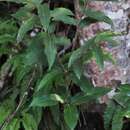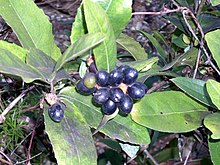fi
nimet breadcrumb-navigoinnissa


Wilkiea huegeliana is a common small tree of rainforest in eastern Australia. Common names include common wilkiea, tetra beech, and veiny wilkiea. Originally described by French naturalist Louis René Tulasne, it was given its current name by Alphonse Pyramus de Candolle.
The natural distribution is from Mount Dromedary (36° S) near Narooma in south eastern New South Wales to Maryborough (25° S) in south eastern Queensland.[1] It has a preference for volcanic soils.[2]
The habitat of the common wilkiea is in the understorey of all forms or rainforest, except cool temperate forest subject to colder temperatures.

Wilkiea huegeliana is a shrub or small tree achieving a height of 8 metres (26 feet), and a stem diameter of 10 cm (3.9 in).[1] The trunk is often crooked and irregular though not buttressed. The bark is smooth, brown or greyish, though can be somewhat scaly on larger plants.
The leaves measure 5 to 13 cm (2.0 to 5.1 in) long, and 1 to 5 cm (0.39 to 1.97 in) wide, and are opposite on the stem. Elliptic or oblong in shape, they usually have toothed margins, though rarely entire.[1] Rounded at the top, tapering at the stem end of the leaf. Dark and glossy above the leaf, dull and paler underneath. The leaf stalks are 3 to 11 mm long, and are very heavily and noticeably veined, particularly below the leaf.
A dioecious species, the plants are either male or female.[3] The yellow green fragrant flowers form from September to February.[1]
Fruit matures from May to September. The fruiting receptacle is shiny black in colour, 7 to 12 mm in diameter, without a stalk.[3] Several of them sit together on a tubular disk. Regeneration is from fresh seeds that stand out white on the darker forest floor, after having been dropped by birds.
Wilkiea huegeliana is most likely pollinated by Thrips setipennis, a species of thrips. These insects have been found in both male and female flowers.[4][5][6][7]
Wilkiea huegeliana is a common small tree of rainforest in eastern Australia. Common names include common wilkiea, tetra beech, and veiny wilkiea. Originally described by French naturalist Louis René Tulasne, it was given its current name by Alphonse Pyramus de Candolle.
The natural distribution is from Mount Dromedary (36° S) near Narooma in south eastern New South Wales to Maryborough (25° S) in south eastern Queensland. It has a preference for volcanic soils.
The habitat of the common wilkiea is in the understorey of all forms or rainforest, except cool temperate forest subject to colder temperatures.
Wilkiea huegeliana es una planta muy común del bosque lluvioso del este de Australia. Nombres comunes incluyen Wilkiea Común (Common Wilkiea), Haya tetra (Tetra Beech), y Wilkiea venosa (Veiny Wilkiea). Originalmente descrita por el naturalista francés Louis René Tulasne, su nombre actual le fue dado por Alphonse Pyrame de Candolle.
Su rango de distribución natural es desde Mount Dromedary (36° S) cerca del poblado de Narooma en el sureste de Nueva Gales del Sur hasta Maryborough (25° S) en el sureste de Queensland.[1] Tiene preferencia por suelos volcánicos.[2]
El hábitat de la Wilkiea común es el sotobosque en todas sus formas o el bosque lluvioso, excepto las formaciones forestales sujetos a temperaturas frías.
Wilkiea huegeliana es un arbusto o árbol pequeño que alcanza una altura de 8 metros, y un diámetro en el tronco de 10 cm.[1] El tronco es con frecuencia torcido e irregular pero no ensanchado en la base. La corteza es lisa, café o grisácea, sin embargo puede ser algo escamosa en las plantas maduras.
Las hojas miden de 5 a 13 cm de largo, y de 1 a 5 cm de ancho, y son opuestas en el tallo. Son de forma elíptica u oblonga, éstas usualmente tienen márgenes dentados, sin embargo son raramente enteras.[1] Redondeadas en la parte superior, se estrechan en el extremo que da al tallo. Oscuras y brillosas en el haz, opacas y más pálidas en el envés. Los tallos de las hojas miden de 3 a 11 mm de largo, y son fuertemente y notablemente venosas, particularmente en el envés.
Es una especie dioica, las plantas pueden ser machos o hembras.[3] Las flores amarillas fragantes se forman de septiembre a febrero.[1]
El fruto madura de mayo a septiembre. El receptáculo frutícola es de color negro brilloso, de 7 a 12 mm de diámetro, sin un tallo.[3] Algunos de ellos se posan juntos en un disco tubular. La regeneración se logra por medio de las semillas frescas.
Wilkiea huegeliana es en su mayor parte polinizada por Thrips setipennis, una especie de Thysanoptera. Estos insectos han sido encontrados tanto en flores macho o hembra.[4][5][6][7]
Wilkiea huegeliana es una planta muy común del bosque lluvioso del este de Australia. Nombres comunes incluyen Wilkiea Común (Common Wilkiea), Haya tetra (Tetra Beech), y Wilkiea venosa (Veiny Wilkiea). Originalmente descrita por el naturalista francés Louis René Tulasne, su nombre actual le fue dado por Alphonse Pyrame de Candolle.
Su rango de distribución natural es desde Mount Dromedary (36° S) cerca del poblado de Narooma en el sureste de Nueva Gales del Sur hasta Maryborough (25° S) en el sureste de Queensland. Tiene preferencia por suelos volcánicos.
El hábitat de la Wilkiea común es el sotobosque en todas sus formas o el bosque lluvioso, excepto las formaciones forestales sujetos a temperaturas frías.
Wilkiea hugeliana là một loài thực vật có hoa trong họ Monimiaceae. Loài này được (Tul.) A. DC. miêu tả khoa học đầu tiên năm 1868.[1]
Wilkiea hugeliana là một loài thực vật có hoa trong họ Monimiaceae. Loài này được (Tul.) A. DC. miêu tả khoa học đầu tiên năm 1868.